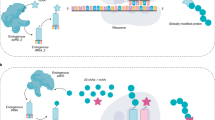Abstract
Genetic encoding of custom designed non-canonical amino acids has emerged as one of the most versatile tools to install site-specific “click-reactive” functionalities into proteins. These non-toxic groups can readily react with suitable substances carrying a compatible clickchemistry. The technology can be used for a variety of applications, such as fluorescent labelling of protein in cells to visualize molecular machines and to custom-engineer better drugs.
Similar content being viewed by others
Literatur
Stephanopoulos N, Francis MB (2011) Choosing an effective protein bioconjugation strategy. Nat Chem Biol 7:876–884
Liu CC, Schultz PG (2010) Adding new chemistries to the genetic code. Annu Rev Biochem 79:413–444
Lemke EA (2014) The exploding genetic code. Chembiochem 15:1691–1694
Chin JW (2014) Expanding and reprogramming the genetic code of cells and animals. Ann Rev Biochem 83:379–408
Liu DR, Schultz PG (1999) Progress toward the evolution of an organism with an expanded genetic code. Proc Natl Acad Sci USA 96:4780–4785
Chen PR, Groff D, Guo J et al. (2009) A facile system for encoding unnatural amino acids in mammalian cells. Angew Chem Int Ed Engl 48:4052–4055
Mukai T, Kobayashi T, Hino N et al. (2008) Adding llysine derivatives to the genetic code of mammalian cells with engineered pyrrolysyl-tRNA synthetases. Biochem Biophys Res Commun 371:818–822
Neumann H, Peak-Chew SY, Chin JW (2008) Genetically encoding N(epsilon)-acetyllysine in recombinant proteins. Nat Chem Biol 4:232–234
Kolb HC, Finn MG, Sharpless KB (2001) Click chemistry: diverse chemical function from a few good reactions. Angew Chem Int Ed Engl 40:2004–2021
Bertozzi CR (2011) A decade of bioorthogonal chemistry. Acc Chem Res 44:651–653
Plass T, Milles S, Koehler C et al. (2011) Genetically encoded copper-free click chemistry. Angew Chem Int Ed Engl 50:3878–3881
Plass T, Milles S, Koehler C et al. (2012) Amino acids for Diels-Alder reactions in living cells. Angew Chem Int Ed Engl 51:4166–4170
Nikic I, Plass T, Schraidt O et al. (2014) Minimal tags for rapid dual-color live-cell labeling and super-resolution microscopy. Angew Chem Int Ed Engl 53:2245–2249
Lang K, Davis L, Torres-Kolbus J et al. (2012) Genetically encoded norbornene directs site-specific cellular protein labelling via a rapid bioorthogonal reaction. Nat Chem 4:298–304
Koehler C, Sauter PF, Wawryszyn M et al. (2016) Genetic code expansion for multiprotein complex engineering. Nat Methods, doi: 10.1038/nmeth.4032
Ducry L, Stump B (2010) Antibody-drug conjugates: linking cytotoxic payloads to monoclonal antibodies. Bioconjug Chem 21:5–13
Nikic I, Girona GE, Kang H et al. (2016) Debugging eukaryotic genetic code expansion enables site-specific Click-PAINT super-resolution microscopy. Angew Chem, doi: 10.1002/anie.201608284R1
Author information
Authors and Affiliations
Corresponding author
Additional information
Christine Köhler Jahrgang 1981. Biotechnologiestudium an der Fachhochschule Bingen. 2006–2009 wissenschaftliche Technikerin am EMBL Heidelberg in der Gruppe Prof. Dr. D. Suck. Ab 2009 in der Gruppe bei Dr. E. Lemke, dort seit 2012 Laboratory Officer. Seit 2016 Scientific Research Manager.
Edward A. Lemke Jahrgang 1978. 1999–2000 Master of Science. Department of Chemistry and Biochemistry, University of Oklahoma, USA. 1997–2001 Diplom in Chemie, TU Berlin. 2002–2005 Promotion, Max-Planck-Institut für Biophysikalische Chemie, Göttingen. 2005–2008 Joint Research Associate, The Scripps Research Institute, La Jolla, CA, USA. Seit 2009 unabhängiger Gruppenleiter am EMBL Heidelberg, Structural and Computational Biology Unit.
Rights and permissions
About this article
Cite this article
Koehler, C., Lemke, E.A. Neue seitenspezifische Proteinfunktionalität mit einem Klick. Biospektrum 22, 704–707 (2016). https://doi.org/10.1007/s12268-016-0747-3
Published:
Issue Date:
DOI: https://doi.org/10.1007/s12268-016-0747-3




